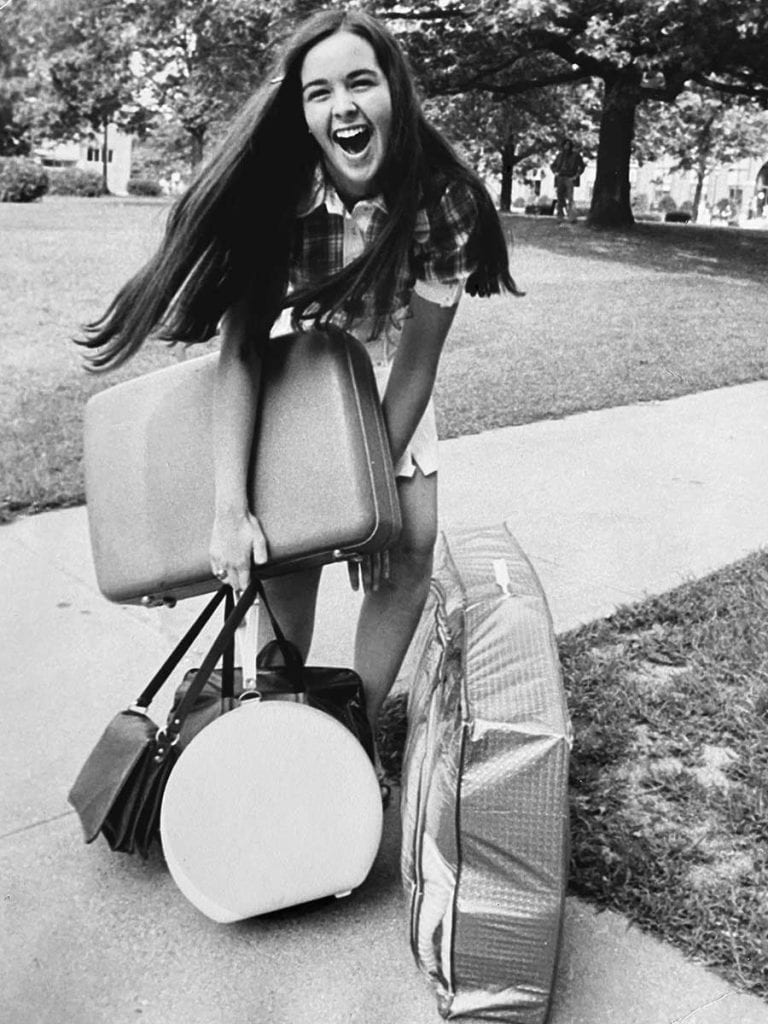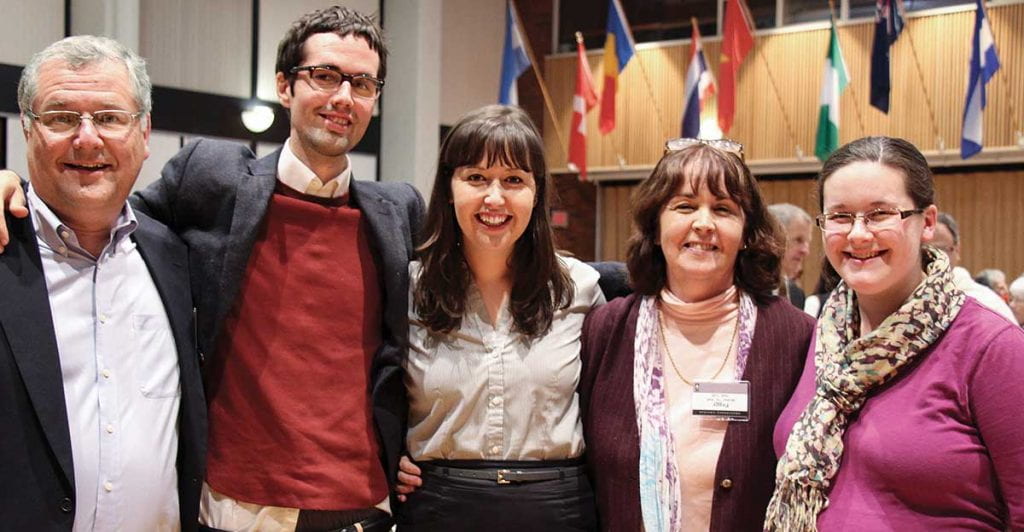Coeds to Concannon: Staying true through decades of change
By Peggy Martin Weber ’76, ’04P, ’06P, ’10P
On my second day at Providence College in 1972, the man who punched my meal card spoke to me like a dear friend. He smiled and said, “You’re the girl from the newspaper.”
I looked at him with confusion, an even greater look of confusion than the one I had been showing since becoming a college freshman. He told me my picture was on the front page of The Providence Journal and offered to bring the paper in the next day. But I didn’t need to see the front page to know what would be depicted.
You see, my first day at PC began with another strange interaction. A Providence Journal photographer approached me as I arrived on campus. It was a bright, sunny Sunday and I was eager to move into my triple on the third floor of McDermott Hall. He asked me to stand next to my luggage for a picture. With all the wisdom of my 17 years and a full semester of high school journalism in my tool belt, I told the man that posed pictures were not the best and he should look around for a candid. We chatted. I told him my name and that I was from Springfield, Mass. I hoisted my under-the-bed sweater bag, purse, suitcase, hair dryer (which came in a case that was larger than some microwaves today), and my trusty electric typewriter. Then the handle broke on the sweater bag and everything slipped. I looked up to see the man snapping photos of me. I laughed and thought no more of it.
He, of course, had the last laugh as he got his candid photo and put me in the paper.

It was a strange and humbling beginning, but the rest of my years at PC were a joy. I loved my time there so much that I asked my oldest child, Kerry, to consider my alma mater when she began to look at colleges. She resisted but eventually gave in, and in the fall of 1999 we found ourselves strolling around Slavin Center. At the time the student mailboxes were located in the basement, exactly where they were when I was a student. I walked up to my old mailbox and tried the combination — middle of H, left side of V. The box opened. Kerry was horrified and amazed. She looked around as if we were going to be arrested. I laughed out loud to think the combination was the same from 27 years ago.
And then we saw something else that had not changed. We wandered toward Alumni Hall and heard music coming from the gym. It was the Mass for Freshman Parents’ Weekend — sweet and solemn. Suddenly, I had tears in my eyes. We witnessed that the importance of faith was as strong as ever. Kerry must have seen this, too, because she decided to apply to the school.
I was among the second class of women admitted to PC, and female students — or coeds, as we were known — were in the minority. But long before the time Kerry moved her belongings into McVinney there were more women than men at PC. Back then, her hair dryer did not weigh 15 pounds. She did not yet have a cell phone and used the landline in her room to call home to talk of new friends and amazing professors. We even had some of the same great ones — Drs. Rodney Delasanta, Richard Grace, and Brian Barbour.
The campus underwent changes, and even the mailboxes found a new home. They were moved to Mural Lounge, a space I knew well. I worked there serving “continental breakfast.” The name sounds fancy but it was just coffee and donuts. My job was to punch the meal tickets of those attending. In addition to a paycheck I was given the name “Peggy Donut.” It was a tradition. I worked with my good friend, “Mary Donut.” Her job was to refill the trays of donuts and keep up the supply of paper plates. I loved that job and had a soft spot for the lounge. Kerry would often hear me bemoan the fact that Mural Lounge was now devoted to mailboxes.
“I used to go there at night for a snack. And I worked there every morning,” I would say. She would sigh and say, “Enough about the mailboxes!”
My son, Matthew, followed two years later. On our visits, I noticed that the cafeteria had a fancy waffle iron and more food choices than I ever had. But the kindness and sense of welcome from the staff were the same.
By the time my youngest child, Elizabeth, arrived on campus in 2006, laptops were the norm and everyone had cell phones. The new (Concannon) fitness center was nothing like the small exercise room female students had in my day. And I knew that no matter how many buildings changed on campus that PC was still a place that encouraged academic excellence and the pursuit of truth.

In my decades of connections with PC I saw many dramatic changes, especially with the expanding campus and services, but I also saw that it remained a community that stayed the course on what matters. St. Dominic Chapel was dedicated shortly after Kerry began at PC. It is a beautiful space, but I especially appreciate the way in which this “new” chapel incorporated a little alcove to pray for the PC women who died in the tragic fire on Dec. 13, 1977. Whenever I visit, I make a point of stopping there to pray for those women. This habit of remembering and praying transcends the years.
Each time I moved my children into their dorms, they arrived with different technology, personal items, and styles of clothing. (None of them, thank God, wore painter’s pants or overalls, as I did.) But they came with hopes, dreams, and a chance to become more. They also felt a deep sense of welcome, just as I did in 1972. And they, like me, left with a more mature faith life and a great education.
Little did I know when I dropped my luggage outside of McDermott what would happen to me in the next four years of PC or the next five decades of my life. So much has changed on campus and in the world, but PC is still a special place for faith and learning. I hope I live to see a few of my eight grandchildren graduate from there. And I will even help them move into their dorms.
Peggy Martin Weber ’76, who majored in English and worked for The Cowl, is an award-winning journalist who spent most of her 37-year career in Catholic communications with the Diocese of Springfield, Mass. She is the author of the self-worth book Enough As You Are (Loyola Press; 2019).





